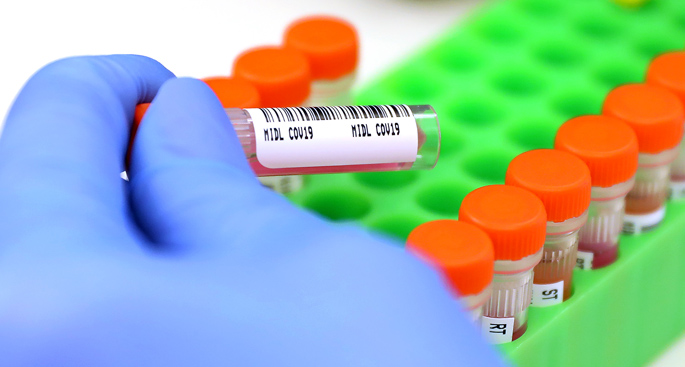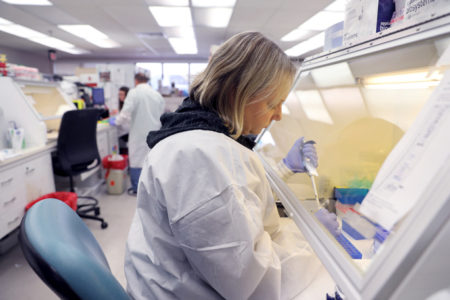
On March 9, four days after the first case of COVID-19 was reported in Tennessee, the first nasopharyngeal swab from a potentially infected person was delivered to the Molecular Infectious Disease Lab at Vanderbilt University Medical Center.
Forty-three days later, on April 21, the lab had tested 15,190 swab samples from residents of Middle Tennessee. An additional 3,415 specimens were collected at VUMC outpatient clinical locations and tested by a third-party laboratory.
Statewide, more than 108,000 tests had been performed as of April 21, according to the Tennessee Department of Health. Nearly 7,400 of the tests — 6.8% — were positive for SARS-CoV-2, which causes COVID-19. In comparison, 8.9% of the samples collected by VUMC were positive for the virus.
The rapid ramping up of SARS-CoV-2 testing at VUMC reflects the dedication of the professionals who work in the Clinical Laboratory and also their collaboration with colleagues in research laboratories throughout the Medical Center, officials said.
“We could not have accomplished any of this without collaboration,” said Adam Seegmiller, MD, PhD, executive medical director of the VUMC Clinical Laboratories.
“Collaboration within different sections in the laboratory, as well as between the laboratory, the research operation and the clinical operation, and support from institutional leadership — this is perhaps one of the finest examples of a truly collaborative process I’m aware of in the 11 years I’ve been at Vanderbilt.”

To expedite more widespread testing for SARS-CoV-2, on Feb. 29 the Food and Drug Administration (FDA) issued an Emergency Use Authorization (EUA) to enable laboratories throughout the country to begin using tests they developed and validated, suspending the usual diagnostic approval process.
“There has probably never before been such an acute, unprecedented rise in demand for a given diagnostic test around the country and around the world,” said MIDL Medical Director Jonathan Schmitz, MD, PhD. “There are increasing numbers of commercial tests that are available for coronavirus testing, but unfortunately, just because they are approved for use doesn’t mean they are readily available throughout the country.”
MIDL staff, aided by Jim Chappell, MD, PhD, research associate professor of Pediatrics and a coronavirus expert, quickly began a multi-tiered validation, a process to evaluate laboratory instruments and test methodology to ensure reproducible and accurate results. Soon VUMC was ready to receive specimens.
To determine if a person has been infected by SARS-CoV-2, medical professionals first take a swab specimen from the nose or mouth, and then extract genetic material from the sample using chemicals called reagents.
To confirm the presence of SARS-CoV-2, its single-stranded genetic material, RNA, then must be converted into double-stranded DNA by an enzyme known as reverse transcriptase.
Copies of DNA from the sample must then be amplified a million- to billionfold using an automated procedure known as the polymerase chain reaction (PCR) so that the DNA is in sufficient volume to be detected.
If the DNA from the sample matches the known genome of SARS-CoV-2, the test is positive, meaning that the individual whose nose or mouth was swabbed is infected.
As testing demand increased, a nationwide shortage of the scientific supplies needed to perform the work brought a new challenge, Schmitz said. Not only were reagents in short supply, the lab had depleted its supply of viral transport media, the liquid the swabs are placed into when collected.
While lab personnel, working closely with the Medical Center’s Supply Chain Office, were able to find alternative reagents to continue testing, no viral transport media was available from any vendor.
So they turned to Howard Price, technical supervisor in the VUMC Department of Pathology, Microbiology and Immunology.
Price and his team created thousands of vials of viral transport media. “They really saved the day,” Seegmiller said.
In addition to finding new supply sources, the workforce had to be expanded.
The MIDL lab, which typically runs two shifts a day, six days a week, was converted into a 24/7 operation, and lab technicians from other areas of VUMC were brought in to assist.
An executive order issued by Tennessee Gov. Bill Lee allowed the lab to bring in postdoctoral fellows in biological science fields who didn’t hold a license to conduct clinical testing.
When specimen volume briefly overran the supplies available to run tests, lab leadership had to perform “diagnostic triage,” Schmitz said. While the lab continued to run tests on site for inpatients and for VUMC employees, an additional 3,419 specimens collected at outpatient locations were shipped to a third-party laboratory.
VUMC Labor Pool volunteers throughout the Medical Center were vital in shipping those samples to the outside laboratory during a five-day period when volume was highest, said Eileen Ricker, MBA, MLS, senior director of Operations for VUMC Diagnostic Laboratories.
At first masked, gowned and gloved lab professionals working under a fume hood extracted genetic material from swab specimens manually. But manual extraction is labor-intensive and potentially hazardous, as samples can aerosolize into microscopic droplets in the same way that an infected person can spread the virus by sneezing or coughing.
This is where VUMC’s research enterprise and Biomek FX, an automated liquid handling machine made by the scientific instrument company Beckman Coulter, came in.
Over the March 14-15 weekend, Angela Jones, MS, VANTAGE’s scientific core facility research manager, wrote and validated an automation protocol for extracting SARS-CoV-2 RNA for a Biomek FX in Mallal’s lab on the second floor of Medical Center North (MCN).
By Monday, March 16, the automated extraction protocol was up and running.
“The full capacity of Vanderbilt is being brought to bear (on this),” added Simon Mallal, MBBS, scientific director of the VANTAGE (VUMC Technologies for Advanced Genomics) core. “People have been extraordinarily generous with their time, people, resources and ideas. We are very fortunate to be in this environment.”
Still, “that was a nuisance,” Mallal said. RNA samples had to be walked to his lab from the Clinical Laboratory in The Vanderbilt Clinic, adjacent to the Vanderbilt University Adult Hospital.
So, on March 23 a liquid handler was moved from VANTAGE to the Clinical Laboratory. Jones validated the extraction protocol and the machine started running samples the next day.
VUMC’s clinical and research enterprises are now working together on the development of serological testing capable of detecting the presence of antibodies produced in the blood of people who have been exposed to COVID-19.
Two other researchers, Justin Balko, PhD, PharmD, and Suman Das, PhD, have also been working hard over recent weeks in collaboration with the clinical laboratory to compare and validate assays. Balko is associate professor of Medicine and of Pathology, Microbiology and Immunology, and Das is research associate professor of Medicine.
Serological testing potentially will be able to identify people who have generated immunity to the virus and may safely return to work. It also may help researchers understand why up to 50% of those infected by SARS-CoV-2 don’t exhibit any symptoms. “The demand for that test will be enormous,” Mallal said.












